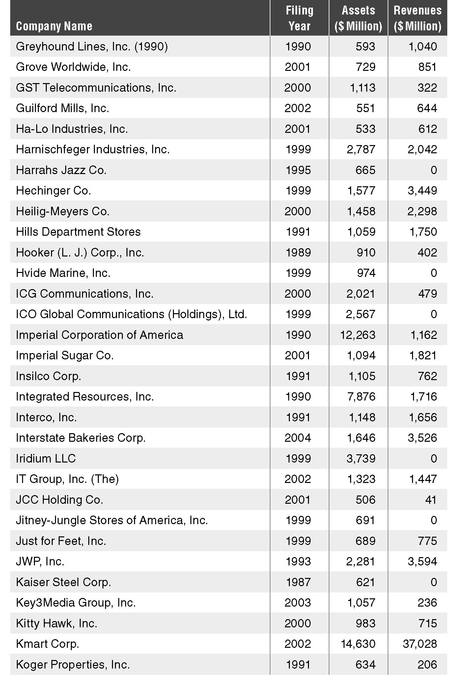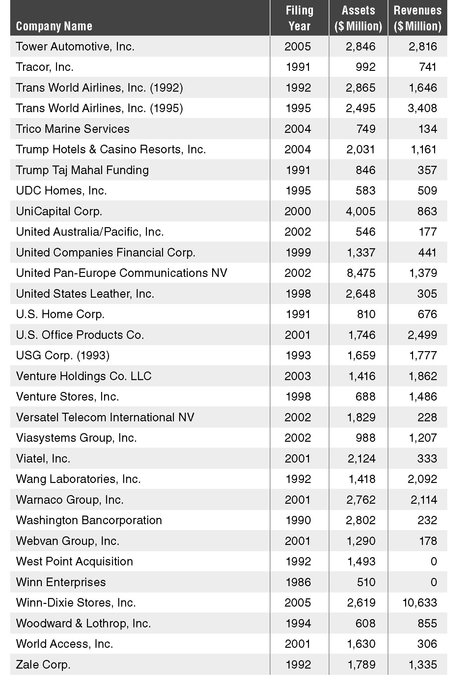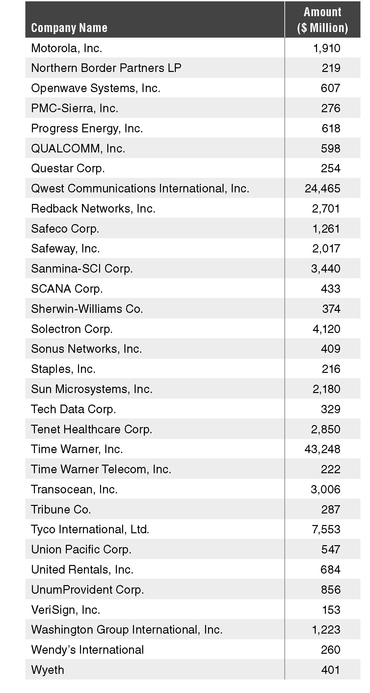Research Notes
Our research looks at the data that others have ignored. Most business research studies successful companies and tries to generalize from their traits, tactics, or strategies. But a serious question always lingers: What about companies that tried to do the same thing as the winners did, but failed?
To glean the lessons from those that have failed, we examined a broad cross section of the most significant business failures between 1981 and 2006. We defined failure as writing off significant investments, shuttering unprofitable lines of business, or filing for bankruptcy.
Working with leading information vendors, including Reuters, Thomson Financial, and
Bankruptcy.com, we built a comprehensive database of more than 2,500 such failures suffered by publicly traded companies in the United States. We picked U.S. public companies because reporting requirements ensured uniformity and access to data while, at the same time, yielding a large enough universe from which to generalize the results. We picked the twenty-five-year period because it was long enough to span multiple economic cycles but recent enough to be relevant to today’s business environment and management practices.
We also did a literature search to look for failures that didn’t show up in the vendors’ databases—for instance, companies that sold themselves before having to account for a major problem.
Then, aided by a team of researchers from Diamond Management & Technology Consultants, we spent more than a year poring over the data. We first applied several financial filters that narrowed the list to the 750 most meaningful. We narrowed bankruptcies to companies with $500 million or more in assets in the last quarter prior to bankruptcy. We narrowed write-offs and discontinued operations to those greater than $100 million, not including write-offs for in-process research and development. (Accounting rules during the years covered by our data required the immediate expensing of all recognized in-process research and development assets following a business combination. These write-offs were a mixed bag; the charges sometimes represented dead-end projects while at other times they were one-time charges against otherwise worthy, continuing projects. Given that it was difficult to distinguish between the two, we chose to ignore the category of write-offs.)
We then did a root-cause analysis, reviewing financial filings, business and popular press reports, and assessments from industry analysts to understand these failures. Using this analysis, we identified repeating patterns, where failures across multiple industries were variations on a theme. We homed in on failures that seemed to be because of strategic failures, rather than environmental factors beyond management control or mishandled implementation. Out of the 750 cases, we found 355 where strategies led directly to major failures. These cases are shown in tables at the end of this section, organized by failure type.
Next, we drilled further into 80 of these strategic failures, selected to give a representative sample across a broad set of industries and failure patterns. In this further analysis, we turned to a wider set of references, including personal interviews, court documents, local newspaper coverage, and business-school cases. The personal interviews included principals involved in the failure, as well as journalists and analysts who covered the events at the time.
From this analysis we drew the lessons about the common problems, the red flags that might alert management to impending failures, and the tough questions that might avert those failures.
Strategic Failures—Bankruptcies
Except in cases where they are used as a strategic device, such as to protect oneself against civil liabilities, bankruptcies are the clearest indicator of failure. The tables that follow show the cases that passed our initial financial screen of greater than $500 million in assets and our preliminary analysis that linked the failure to a particular strategic decision. Assets and revenues shown are from the last quarterly filing before the company’s bankruptcy filing.
STRATEGIC FAILURES—BANKRUPTCIES
STRATEGIC FAILURES—BANKRUPTCIES
STRATEGIC FAILURES—BANKRUPTCIES
STRATEGIC FAILURES—BANKRUPTCIES
STRATEGIC FAILURES—BANKRUPTCIES
STRATEGIC FAILURES—BANKRUPTCIES
STRATEGIC FAILURES—BANKRUPTCIES
STRATEGIC FAILURES—BANKRUPTCIES
Strategic Failures—Write-offs
Write-offs for failed strategies are notoriously hard to isolate. Multiple items are typically combined in what is known, in accounting parlance, as a “big bath charge.” Some also refer to it as “taking out the trash.” In addition, write-offs associated with a particular failure are typically taken over multiple years. Thus, a pure financial analysis is insufficient for identifying individual failures. Instead, we aggregated all write-offs by a particular company over the research period and further investigated the ones that totaled more than $100 million. The table below lists the companies and the write-offs that led us to identify particular strategic failures.
STRATEGIC FAILURES—WRITE-OFFS
STRATEGIC FAILURES—WRITE-OFFS
STRATEGIC FAILURES—WRITE-OFFS
STRATEGIC FAILURES—WRITE-OFFS
Strategic Failures—Discontinued Operations
Discontinued operations do not necessarily denote either a strategic or an execution failure. Sometimes operations are discontinued because of valid strategic shifts; other times they might even denote success, such as when an otherwise sustainable operation is sold. Even in the case of failure, it is sometimes hard to distinguish between strategic and execution failures. This is because the unit might have been in business for some time, making it more difficult to isolate cause and effect related to the failure. In general, we tended to be conservative in designating a discontinued operation as a strategic failure. The table below lists the companies and the write-offs that led us to identify particular strategic failures.
STRATEGIC FAILURES—DISCONTINUED OPERATIONS
STRATEGIC FAILURES—DISCONTINUED OPERATIONS














